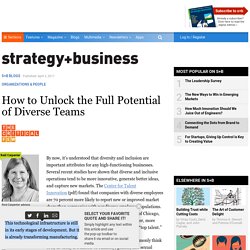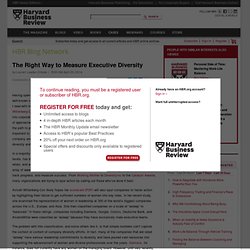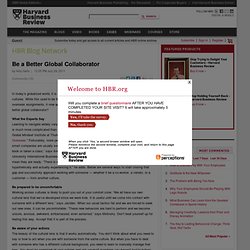

How to Unlock the Full Potential of Diverse Teams. By now, it’s understood that diversity and inclusion are important attributes for any high-functioning businesses.

Several recent studies have shown that diverse and inclusive operations tend to be more innovative, generate better ideas, and capture new markets. The Center for Talent Innovation (pdf) found that companies with diverse employees are 70 percent more likely to report new or improved market share than companies with nondiverse employee populations. A study by Ronald Burt, a professor at University of Chicago, concluded that any diverse group will surface better, more effective ideas than a group of more homogenous “top talent.”
But what exactly qualifies as diversity? As we commonly think of it, diversity is a matter of ethnicity, gender, and sexual orientation, among other inherent differences. But operating in a diverse organization also has its challenges. The Attributes of Real Teams A common purpose. Complementary skills. Shared leadership.
Women. Learning to Speak Up When You're from a Culture of Deference - Andy Molinsky. By Andy Molinsky | 9:00 AM July 7, 2014 Many of us are uncomfortable speaking with people of higher status.

We can feel self-conscious, unsure of what to say, and afraid what we’re going to say — or what we’re saying — is the wrong thing. Diversity Is Useless Without Inclusivity - Christine M. Riordan. By Christine M.

Riordan | 12:00 PM June 5, 2014 Over the past decade, organizations have worked hard to create diversity within their workforce. A Tool That Maps Out Cultural Differences - David Champion. By David Champion | 11:00 AM April 25, 2014 Understanding cultural differences isn’t easy, even when you’ve lived in many different countries (disclosure: I’m a Brit, grew up in Southeast Asia, lived and worked in Switzerland and the US, and now live and work in France).

Just when you think you’ve got a culture nailed, something happens that your mental model hasn’t predicted. Americans, world-famous for candor and directness, struggle when it comes to giving tough feedback, even when it’s needed. The Right Way to Measure Executive Diversity - Lauren Leader-Chivée. By Lauren Leader-Chivée | 8:00 AM April 30, 2014 Having spent the last five years of my career working hand in hand with many of the world’s most well-known companies on efforts to advance women and diverse professionals into leadership roles, I read with interest the recent study and blog post by my esteemed colleague Avivah Wittenberg-Cox.

Avivah has undertaken an ambitious scorecard to measure the progress of women into corporate leadership around the world. Be a Better Global Collaborator - Amy Gallo. In today’s globalized world, it is essential to know how to collaborate with people from different cultures.

While this used to be the case primarily for country managers and those taking on overseas assignments, it now applies to all managers. But exactly how does one learn to become a better global collaborator? What the Experts Say Learning to navigate widely varying business practices is far from straightforward. “Global leadership is much more complicated than leading people like you,” says Mansour Javidan, the Director of the Global Mindset Institute at Thunderbird School of Global Management and author of “Making It Overseas.”
Fear of Being Different Stifles Talent. Diversity is a near-universal value in corporate America, but the upper tiers of management remain stubbornly homogeneous.

Consider Fortune 500 CEOs: Only 23 are female, just six are black, and none are openly gay. Why so few gains at the top? We believe that one factor is a phenomenon sociologists call “covering,” whereby people downplay their differences from the mainstream. Someone with a disability might forgo her cane at work, say, while a gay man might avoid using “he” or “him” if asked about his partner. Such behavior is driven not just by self-censorship or internalized biases but also by pressure from managers. We reached these conclusions after surveying some 3,000 employees in more than 20 large U.S. firms.
Of the employees who reported feeling pressure to mute some aspect of their identities, 66% said that it significantly undermined their sense of self. Stop "Fixing" Women and Start Fixing Managers - Avivah Wittenberg-Cox. By Avivah Wittenberg-Cox | 10:00 AM February 12, 2014 We are finally getting to a tipping point on the analysis of gender imbalances in companies.

After decades of pointing the finger at women and what they do, don’t do, or do too much, a chorus of voices is finally being raised putting responsibility for balance where it belongs: with business leaders. “The lack of women in an organisation is a management failure,” says a recent report published by King’s College London and sponsored by KPMG. I’ve seen the same in my work with large multinationals: There is only one key success criteria for gender balancing organisations, and that is leadership.
White People Do Good Things for One Another, and That's Bad for Hiring - Nancy DiTomaso. By Nancy DiTomaso | 10:00 AM January 2, 2014 At some point in your career, you were probably turned down for a job at a new organization in favor of an “internal” candidate.

Most of us have had that experience. It’s even more likely (though you probably weren’t aware of it) that you’ve been rejected at times in favor of outside applicants who were known quantities to the hiring managers—candidates who were referred by other employees or recommended by friends of friends. Cultural Coaching: Knowing When to Shut Up - Erin Meyer. By Erin Meyer | 10:00 AM January 14, 2014 Anyone who’s spent time in another culture will be aware that the norms and assumptions around conducting meetings are a minefield.

But while you can easily accept that in theory, you may have to blow yourself up to really get the point. My big lesson in how not to conduct a multicultural meeting came, ironically enough, when I was supposed to be coaching a top executive at French car manufacturer Peugeot Citroën and his wife in preparation for the cultural adjustments they’d need to make in their upcoming move to Wuhan, China. Bo Chen, the Chinese country expert assisting me, arrived early. Does a lack of diversity among business leaders hinder innovation? A lack of diversity among business leaders may mean companies are failing to see the potential in people and ideas they cannot relate to. Photograph: Roger Ressmeyer/© Roger Ressmeyer/CORBIS When fourth-quarter financials showed Beam, the bourbon purveyor, to have boosted net sales in 2011 to $2.3bn, CEO Matt Shattock congratulated his executive team for having the infinite wisdom to acquire Skinnygirl, the line of pre-mixed cocktails created by reality-TV star Bethenny Frankel in 2009.
In its first year as a Beam product, Skinnygirl posted a staggering 486% in net sales growth. "We see Skinnygirl cocktails as an excellent platform for long-term value creation," Shattock told investors. Indeed, in 2012 the brand helped push Beam Global to a record $2.5bn in net sales.